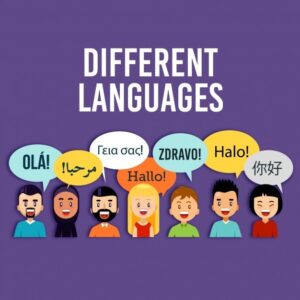Multilingual societies represent dynamic tapestries composed of various languages and cultures, thereby enhancing both individual lives and collective experiences through linguistic diversity and multiculturalism.
This article aims to explore the significance of multilingualism, analyzing its advantages for individuals, linguistic minorities, and societies as a whole.
By conducting a comprehensive examination of Switzerland and India—two countries characterized by their unique multilingual contexts and official languages—we reveal how effective language policies can promote unity and cultural identity.
We emphasize the importance of inclusivity and respect in navigating the complexities of the multilingual landscape, particularly in multilingual education and community engagement.
What Are Multilingual Societies?
.jpg_00.jpeg)
Multilingual societies are defined by the coexistence of multiple languages, which reflects the intricate cultural integration and linguistic identity that arise from the interaction and communication among diverse ethnic groups.
In these societies, language diversity not only enhances the social fabric but also plays a vital role in fostering societal cohesion and overcoming communication barriers. It facilitates effective communication across various language communities and promotes intercultural dialogue.
This phenomenon is particularly evident in regions such as Switzerland and India, where multilingualism is a fundamental aspect of national identity, regional languages, and daily life.
The Importance of Multilingualism
Multilingualism holds significant importance in today’s globalized context, as it promotes societal cohesion, enhances intercultural competence, and facilitates communication among various ethnic groups, supporting language rights and cultural exchange. This, in turn, contributes to economic development and social inclusion.
In multilingual societies, the implementation of effective language policies and multilingual education systems is crucial for overcoming language barriers and advancing language rights. Such measures ensure that all community members can engage fully in public discourse, overcome language barriers, and participate actively in civic life.
How Does Multilingualism Benefit Individuals?
Multilingualism presents numerous advantages for individuals, including enhanced cognitive function, improved language acquisition capabilities, and expanded opportunities for identity expression. These benefits can lead to increased social inclusion, better language acquisition, and more effective communication within diverse communities.
By mastering multiple languages, individuals can adeptly navigate various sociocultural dynamics and forge stronger connections with different ethnic groups, thereby enriching both their personal and professional lives through language use and cultural integration.
The cognitive benefits of multilingualism are particularly significant; research has demonstrated that bilingual individuals often exhibit improved problem-solving skills, language fluency, and heightened creativity, which can be attributed to their capacity to switch between different linguistic frameworks.
In the contemporary global job market, proficiency in more than one language considerably enhances an individual’s employability, as employers increasingly prioritize candidates who can communicate effectively with diverse clientele and collaborate within multicultural teams.
For instance, a recent case study illustrated how a bilingual community manager not only cultivated stronger relationships with international partners but also boosted engagement within localized markets, highlighting the tangible impact of multilingual skills in a professional context.
How Does Multilingualism Benefit Societies?
Multilingualism plays a vital role in benefiting societies by promoting social cohesion, enhancing intercultural dialogue, preserving cultural heritage, and supporting heritage languages. It also contributes to the reduction of social stratification and fosters inclusivity among various ethnic groups.
Within multilingual societies, the presence of multiple languages facilitates a richer exchange of cultural narratives, thereby strengthening community identity, supporting the maintenance of languages across generations, and fostering cross-cultural interaction.
This linguistic diversity not only enhances communication among different ethnic groups but also enriches public administration by ensuring that government services are accessible to all citizens, irrespective of their linguistic backgrounds, which is vital for linguistic rights and social justice. For example, countries such as Canada, which officially recognizes both English and French, illustrate how multilingualism can enhance civic engagement and participation.
Moreover, businesses operating in multilingual regions often experience economic advantages by engaging with diverse customer bases, resulting in innovative ideas and services tailored to various communities. The ability to communicate in multiple languages fosters social cohesion and mutual respect, encouraging both individuals and institutions to recognize and embrace diversity as a significant asset.
Switzerland: A Case Study of a Successful Multilingual Society
Switzerland represents a notable case study of a successful multilingual society, in which four national languages—German, French, Italian, and Romansh—coexist in a harmonious manner.
This coexistence is supported by well-defined language policies that promote cultural integration and respect for regional languages.
The Swiss model of multilingualism underscores the significance of community engagement and the active involvement of diverse linguistic groups in the development of a cohesive national identity.
This approach is essential for fostering intercultural competence and enhancing mutual understanding among the population.
The History and Context of Multilingualism in Switzerland
The history of multilingualism in Switzerland is characterized by a rich and complex evolution, shaped by centuries of sociolinguistic changes, language policies, and the interactions of various language communities. This process has culminated in the formation of a distinctive linguistic landscape that promotes cultural pluralism and respect for diversity.
The multilingual framework has been influenced by migration patterns, regional languages, and the necessity for effective communication among a Swiss population composed of diverse ethnic groups, all of which contribute to the nation’s linguistic identity and cultural integration.
Over the centuries, significant historical events—such as the Reformation, which facilitated the spread of the German language, and the industrial revolution, which induced urbanization—have further impacted the multilingual environment. The formulation of language policies following World War II, designed to foster unity amidst diversity, represented a crucial turning point in ensuring that all four national languages—German, French, Italian, and Romansh—are accorded equal recognition, emphasizing language planning and policy frameworks.
This evolution also mirrors changes in cultural identity, where efforts to maintain languages have been essential, particularly for minority groups, in preserving their heritage in the face of prevailing linguistic trends and societal dynamics.
The Role of Language Policies in Maintaining Multilingualism in Switzerland
.jpg_01.jpeg)
Language policies in Switzerland are essential for sustaining a vibrant multilingual society, ensuring that all four national languages are recognized and supported through effective public administration, advocacy for language rights, and language preservation.
These policies not only promote multilingual education but also facilitate language preservation and revitalization efforts, respecting the linguistic diversity and cultural heritage of each language community.
By establishing frameworks that encourage language learning in educational institutions and local communities, these policies create an environment that fosters deeper engagement with diverse cultures. The promotion of language rights contributes to a sense of belonging among various linguistic groups, leading to enhanced community participation.
In this manner, individuals are equipped to navigate their multilingual surroundings and are inspired to contribute to social cohesion, ensuring that all voices are acknowledged and valued.
This rich tapestry of languages ultimately strengthens the social fabric of Switzerland, underscoring the significance of inclusive policies in an increasingly globalized world.
The Impact of Multilingualism on Swiss Society and Culture
The impact of multilingualism on Swiss society and culture is significant, influencing various aspects ranging from social interactions to cultural heritage, while fostering community cohesion, intercultural communication, and intercultural dialogue among different linguistic groups.
In Switzerland, the coexistence of regional languages not only enriches the cultural landscape but also reinforces a shared identity and collective belonging among its diverse population.
This linguistic diversity offers a unique framework for individuals to express their identities, often resulting in a rich tapestry of cultural exchanges, language and identity interactions, that celebrate differences and promote mutual respect.
In their daily lives, residents engage with various languages that serve as gateways to understanding regional customs, literature, and traditions. As a result, these interactions enhance community resources, facilitating greater collaboration among different groups and ultimately contributing to a more inclusive society.
The resulting sociocultural dynamics are both noteworthy and essential in shaping the Swiss way of life, fostering resilience and adaptive learning in a constantly evolving sociolinguistic environment.
India: A Case Study of a Complex Multilingual Society
India serves as a prime example of a complex multilingual society, characterized by the coexistence of numerous languages that reflect the country’s extensive linguistic diversity, cultural heritage, and rich cultural heritage, shaped by various ethnic groups and historical migrations.
This diverse linguistic landscape presents both challenges and opportunities for effective communication and intercultural dialogue, highlighting the necessity of navigating the intricate dynamics of multilingualism within Indian society. This emphasizes the importance of language and identity in bridging communication barriers and fostering societal cohesion.
The History and Context of Multilingualism in India
The history of multilingualism in India is intricately woven into its sociolinguistic fabric, wherein the interaction of diverse languages and dialects has significantly influenced the nation’s identity and cultural narratives over the centuries. This rich tapestry is further complicated by the presence of regional languages and the impact of globalization on language use.
This complex history encompasses the coexistence of heritage languages, regional languages, and the impact of globalization, all of which contribute to the nuanced dynamics of language use within Indian society. It underscores the significance of language diversity and the societal challenges encountered in maintaining linguistic harmony.
From ancient trade routes that introduced various languages to the contemporary era of digital communication, the evolution of language communities in India serves as a testament to the country’s adaptability and resilience. The narrative of language evolution also includes the role of bilingualism and language maintenance in preserving cultural heritage.
Significant historical events, such as the colonial period, introduced English and other foreign languages into the linguistic landscape, thereby reshaping linguistic hierarchies and creating new opportunities for cultural exchange. This period marked a shift in language attitudes and emphasized the role of language policy in shaping societal norms.
Sociolinguistic factors, including regional pride and migration patterns, further enhance this multilingual environment, resulting in a rich tapestry of linguistic identities. These factors play a crucial role in language preservation and the revitalization of indigenous and tribal languages.
As individuals continue to traverse both internal and external borders, the interplay between languages evolves, reflecting the dynamic nature of the social fabric and fostering a vibrant multilingualism that is essential to India’s identity. This evolution highlights the importance of intercultural communication and the role of language tools in enhancing cross-cultural interaction.
The Challenges and Opportunities of Multilingualism in India
Multilingualism in India presents a unique array of challenges and opportunities. The coexistence of numerous languages can give rise to language barriers, social stratification, and issues concerning language rights, while simultaneously facilitating rich cultural exchanges and promoting social inclusion. It also involves addressing identity politics and ensuring linguistic rights are upheld.
Addressing these challenges necessitates the implementation of effective language policies and the provision of community resources that foster educational equity and enable marginalized linguistic groups. This approach supports language revitalization and community engagement essential for sustainable multilingual education.
The diverse linguistic landscape requires many individuals to navigate multiple cultural identities, which can enhance their societal roles or, conversely, lead to feelings of alienation. Educational institutions are tasked with the intricate responsibility of developing curricula that not only respect regional languages but also promote a national language to ensure unity while safeguarding local languages.
Promoting language rights is crucial for enhancing social inclusion, enabling individuals from diverse linguistic backgrounds to participate actively in public life. This duality underscores both the richness of India’s diversity and the urgent need for policies that strike a balance between unity and respect for individual linguistic identities. Effective language planning and policy frameworks are essential to address these societal dynamics.
The Role of Language Policies in Managing Multilingualism in India
Language policies in India are essential for managing the complexities associated with multilingualism. These policies aim to promote the use of official languages while also respecting regional languages and fostering language development across diverse communities. They also play a role in facilitating language acquisition and language mapping to ensure comprehensive language documentation.
They address critical areas such as language acquisition, educational systems, and public administration, ensuring that all linguistic groups can exercise their language rights and maintain their linguistic identity. This effort is crucial for promoting multiculturalism and accommodating diverse social structures.
The effectiveness of these policies transcends mere communication; they significantly contribute to enhancing community engagement and social cohesion. By promoting language fluency and bilingualism, these policies facilitate better intercultural dialogue and citizen participation.
By incorporating local languages into educational curricula, children are equipped not only with academic knowledge but also with a sense of belonging and connection to their cultural heritage. This approach supports language and culture integration, fostering identity and assimilation in multilingual societies.
Furthermore, these policies facilitate the participation of various linguistic groups in governance and public discourse, thereby allowing for inclusive representation. This inclusive approach is vital for ensuring political representation and social justice for linguistic minorities.
As India continues to evolve as a multilingual society, the ongoing assessment and refinement of these language policies will be pivotal in determining their success in fostering an environment where diversity is celebrated and linguistic rights are upheld.
Lessons Learned from Switzerland and India
.jpg_10.jpeg)
The insights gleaned from the experiences of Switzerland and India offer significant lessons in the management of multilingualism. These lessons highlight the essential roles of language policies, educational systems, and community engagement in promoting cultural integration and facilitating effective communication among various ethnic groups. The comparison emphasizes the importance of understanding demographic trends and language shift in policy implications.
Both nations exemplify how the thoughtful implementation of multilingual policies can enhance societal cohesion and reinforce the linguistic identity of their respective populations. Effective translation and language planning are integral to supporting multilingual communication and regional identity.
The Importance of Language Policies in Maintaining Multilingualism
Effective language policies are crucial for upholding multilingualism, as they ensure the recognition and protection of language rights, promote societal cohesion, and facilitate public administration across various linguistic communities. They also address language accessibility and the economic impact of language and power dynamics.
Both Switzerland and India serve as prime examples of how robust language policies can foster an environment in which diverse languages thrive, thereby enriching the cultural landscape and promoting intercultural dialogue. Their approaches include language maintenance and media representation to support cultural exchange.
In Switzerland, the Federal Constitution recognizes four national languages—German, French, Italian, and Romansh—enabling citizens to interact with their government in their language of choice. This level of inclusivity not only strengthens national identity but also supports educational frameworks that embrace multilingualism from an early age, promoting language teaching and education systems that nurture language learning.
Similarly, India’s recognition of 22 languages promotes a vibrant array of cultural expressions. Provisions such as the Eighth Schedule encourage the use of regional languages in educational and governmental contexts, ensuring that linguistic minorities receive equitable representation. These measures support the preservation of local dialects and contribute to societal dynamics and social identity.
Consequently, these language policies not only serve to preserve languages but also cultivate a sense of belonging and enhance mutual respect among diverse communities. This approach aligns with global citizenship and the need for inclusive, respectful language practices.
The Role of Education in Promoting Multilingualism
Education plays a critical role in fostering multilingualism, as effective educational systems not only facilitate language acquisition but also promote community engagement and cultural exchange among diverse linguistic groups. By prioritizing multilingual education, societies can enable individuals to overcome language barriers and participate fully in their communities, thereby enhancing social inclusion and intercultural competence. This approach also addresses language stratification and supports urban and rural multilingualism.
To achieve these objectives, educational institutions can implement innovative methodologies such as:
- Immersive language programs
- Content-based instruction
- Collaborative projects that encourage interaction among learners from different linguistic backgrounds
Engaging families and local communities is equally important; outreach programs that celebrate cultural heritage can create a supportive environment for language learning. These programs are essential for language and culture integration and ensuring the vitality of indigenous languages.
Moreover, teacher training that emphasizes multicultural approaches equips educators with the skills necessary to nurture multilingual classrooms effectively. This approach is crucial for addressing language and technology advancements and supporting language interactions.
In this manner, the educational landscape evolves into a dynamic environment where languages are not merely taught but experienced, contributing to a richer and more inclusive society. This transformation supports cross-cultural interaction and prepares individuals for global citizenship and active participation in multicultural societies.
The Impact of Multilingualism on National Identity and Unity
Multilingualism significantly influences national identity and unity, as it embodies the rich cultural heritage and diverse expressions of identity present within multilingual societies. By embracing linguistic diversity, nations can cultivate societal cohesion and promote a sense of belonging among various ethnic groups, thereby contributing to the development of a strong and inclusive national identity. This acceptance of diversity supports language preservation and the revitalization of community language practices.
For example, in Switzerland, where four official languages coexist, the recognition and promotion of each language foster a distinctive sense of unity among its citizens. This multilingual environment not only celebrates regional identities but also enhances communication and cooperation among different linguistic communities. It highlights the importance of societal norms and the role of language and power in shaping social identity.
Similarly, in India, the constitution recognizes numerous languages, enabling various groups to preserve their cultural identities while simultaneously forging a national identity that is both vibrant and inclusive. This approach supports language shift management and the empowerment of minority languages through effective policy frameworks.
These examples illustrate how multilingualism can serve as a foundational pillar for constructing a cohesive society that respects and values diversity. Effective multilingual communication and citizenship practices are essential for maintaining cultural integration and fostering inclusive community identity.
The Need for Inclusive and Respectful Language Practices in Multilingual Societies
In multilingual societies, there is a pressing need for inclusive and respectful language practices that acknowledge and uphold the rights of all language communities. This approach is essential for ensuring social inclusion and harmony among diverse groups. It requires language documentation efforts and the promotion of language and culture as pivotal elements of social justice.
By cultivating an environment where all languages are respected and valued, societies can enhance intercultural dialogue and mitigate language-related challenges, ultimately contributing to healthier intergroup relations. This commitment to language accessibility and language teaching supports the sustainable development of multilingual societies.
Such practices not only enable individuals to express their identities but also promote mutual understanding, which is vital for effective collective problem-solving. When language diversity is embraced, it encourages community members to participate more fully in discussions and decision-making processes, thereby enhancing social cohesion. These practices also facilitate language revitalization and the support of diverse sociolinguistics perspectives.
Respectful communication fosters a sense of belonging, allowing marginalized groups and linguistic minorities to feel acknowledged and heard. This cultural integration promotes collaboration across various cultural backgrounds, thereby strengthening the overall fabric of society and ensuring that community engagement is richer and more meaningful for all stakeholders involved. Social cohesion is crucial for this process.
Frequently Asked Questions
What is a multilingual society?
.jpg_11.jpeg)
A multilingual society is a society where people use more than one language, either within their own community or as a whole. This means that there are several languages spoken and recognized within the society. Multilingual societies often involve a variety of regional languages.
A multilingual society is a society where people use more than one language, either within their own community or as a whole. This means that there are several languages spoken and recognized within the society.
What are the benefits of living in a multilingual society?
Living in a multilingual society can provide individuals with a broader cultural perspective, enhanced communication skills, and better job opportunities. It also promotes tolerance and understanding of different cultures and languages. Language diversity enriches the social and cultural fabric of a community.
Living in a multilingual society can provide individuals with a broader cultural perspective, enhanced communication skills, and better job opportunities. It also promotes tolerance and understanding of different cultures and languages.
How does Switzerland handle its multilingual society?
Switzerland has four official languages: German, French, Italian, and Romansh. Each language is given equal recognition and importance, and government documents and services are available in all four languages. This has helped to maintain peace and unity within the country. Switzerland’s approach can serve as a model for multilingual education and language policy.
Switzerland has four official languages: German, French, Italian, and Romansh. Each language is given equal recognition and importance, and government documents and services are available in all four languages. This has helped to maintain peace and unity within the country.
What can we learn from Switzerland’s approach to multilingualism?
We can learn that it is possible for multiple languages to coexist and thrive within a society. By giving equal recognition and support to all languages, Switzerland has been able to create a harmonious and inclusive environment for its citizens, promoting intercultural communication and social inclusion.
We can learn that it is possible for multiple languages to coexist and thrive within a society. By giving equal recognition and support to all languages, Switzerland has been able to create a harmonious and inclusive environment for its citizens.
How is India’s multilingual society different from Switzerland’s?
Unlike Switzerland, India does not have a set number of official languages. It has more than 22 languages recognized by the government, with Hindi and English being the most commonly used. This diversity of languages reflects the rich cultural heritage and ethnic groups of the country, emphasizing the importance of language preservation and regional identity.
Unlike Switzerland, India does not have a set number of official languages. It has more than 22 languages recognized by the government, with Hindi and English being the most commonly used. This diversity of languages reflects the rich cultural heritage of the country.
What challenges do multilingual societies face?
One of the main challenges is maintaining the balance between languages and ensuring that no language is discriminated against or marginalized. This can also lead to conflicts and tensions between different linguistic groups. However, with proper policies and efforts towards promoting inclusivity, these challenges can be overcome. Communication barriers and societal dynamics play significant roles in these challenges.
One of the main challenges is maintaining the balance between languages and ensuring that no language is discriminated against or marginalized. This can also lead to conflicts and tensions between different linguistic groups. However, with proper policies and efforts towards promoting inclusivity, these challenges can be overcome.

My name is Bruno, I have been a writer for 5 years and I work with website creation. My goal is to provide true information to readers. In fact, on this site I write about cultures and traditions, which I have been passionate about since childhood.




